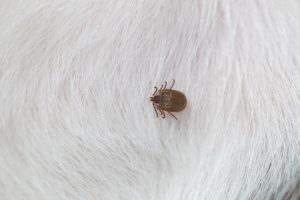Hello pet parents! Boo the dog here, itching to talk to you about a topic that comes up every season and is a real pain in the tail for parents and fur babies alike: fleas and ticks!
While fleas and ticks can be something that affects cats and dogs year-round, this time of year certainly becomes a problem for many places in the United States when the weather gets warmer. If you haven’t been practicing year-round flea and tick prevention, I am here to give you the low-down on what you need to know.
 Dangers of Pet Pests
Dangers of Pet Pests
First of all, other than annoying itching, fleas and ticks can be dangerous to us dogs (and cats too!) because they can carry and cause illnesses and diseases.
Fleas often cause skin diseases, tapeworms and anemia. Ticks can carry Lyme disease and Rocky Mountain Spotted Fever, which affect pets just like it does humans. And while fleas and ticks are usually the main concern for pet parents, often overlooked are mosquitos, which can cause deadly heartworms as well.
Checking Your Pets
We can all agree that fleas and ticks are something we don’t want to deal with, so how do you even go about checking your pet for these pests? I really like it when my mom grooms me or plays with me, and sometimes I don’t even realize she’s actually checking me.
Fleas and ticks can show up anywhere on your pet’s body, so it’s important to look everywhere. Ticks are obviously easier to see, and when found, should be pulled out with tweezers by gripping as close to the head as possible.
However, fleas can be more difficult to spot. The best telltale sign for fleas is that it looks like dirt left behind on your pets’ skin. Black specks that look like dirt are actually flea fecal matter. If you hold a white paper towel under your pet as you run a comb through their coat and it comes up with black specks, chances are they have fleas. If live fleas are spotted during your check, drown them in a soapy bath since they could jump on to you as well.
 Protection Options
Protection Options
It’s ruff as a pet parent to know which flea and tick prevention and treatment options are best since there are so many. Veterinarians agree that taking preventative measures and doing them consistently are the most effective way to keep pests away. However, if your furry friend does get fleas or ticks, there are also ways to rid them and your home of pests. Let’s break down all the treatments available:
-
Spot-on treatments– Frontline and K9 Advantix are the most popular brands for spot-on treatments, and while they carry a higher price tag than other brands, most pet owners find them highly effective. Pet parents can buy them in monthly doses and apply the liquid on their fur baby’s backs once a month. Sometimes I find this part a little itchy, but I get over it quickly and it’s worth it in the long run! Spot-on treatments prevent fleas and ticks from hosting on pets in the first place by killing them when they bite. Cats and dogs have different options available, so be sure to choose the one that is right for your type of pet.
-
Sprays– If your pet already has fleas or ticks, sprays can help kill these pests on contact. Sprays can be effective, but many pet parents worry about the side effects. Read the labels to check the chemicals used before applying and to see if they are okay to use in conjunction with other treatments like topical medications.
-
Oral medications– Controlling fleas and ticks isn’t always skin deep. Oral medications can provide protection from the inside out, and might be a good thing to do year round. Products like Sentinel, for example, protect your pooch from fleas and also protect from nasty intestinal parasites like heartworms, round worms, hookworms, whipworms and tapeworms. Dosages vary by size of dog, so check labels and dosages carefully.
 Controlling pests inside and outside your home
Controlling pests inside and outside your home
If you’ve ever had a go-round with fleas, you know how difficult it can be to rid your home of them. Not only do you need to take care of live adult fleas, but also the majority of fleas in an infestation are in the egg or larvae stage and can stay in carpets and upholstery. However, ridding your home of them can be done!
- Regular vacuuming and the use of insecticides and insect growth regulators will be most effective.
- Insect growth regulators reach those flea eggs and larvae to keep them from developing. If you have a larger infestation, foggers can also be used to help kill fleas that get deep into carpet pads or cracks.
- Finally, always wash any removable fabrics and upholstery in hot water in your washing machine.
- Outside of your home, keep your yard mowed and trimmed to create a less desirable environment for fleas and ticks.
- And even though we love being outside in the nicer weather, we need protection with flea and tick treatment to ensure we don’t bring them back inside with us.
With all of this great advice you can help you furry family members stay “itch free” and healthy this season! Here’s to pool weather for us all!

Leave A Comment
You must be logged in to post a comment.